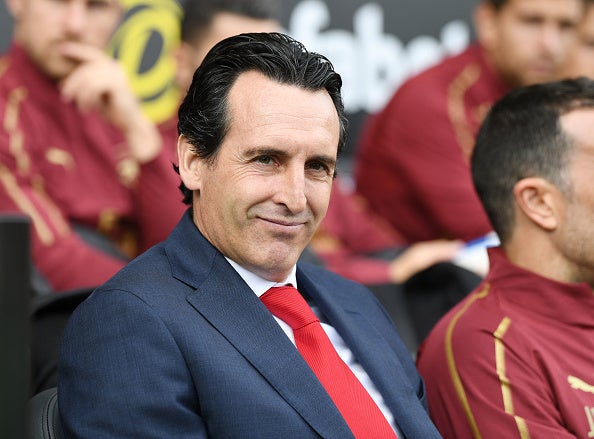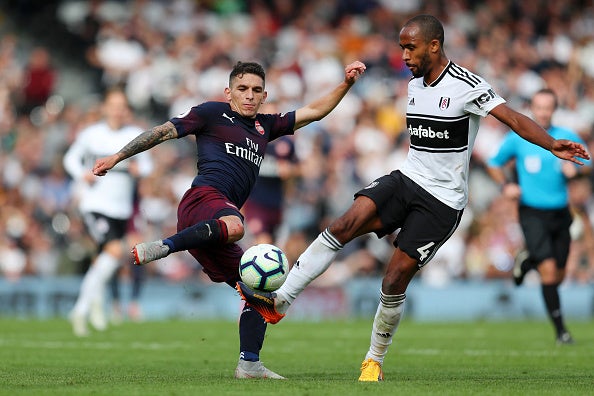How Unai Emery has revitalised the 'Arsenal DNA'
The ideology which Arsene Wenger so famously birthed then betrayed has been resurrected in his absence

Your support helps us to tell the story
From reproductive rights to climate change to Big Tech, The Independent is on the ground when the story is developing. Whether it's investigating the financials of Elon Musk's pro-Trump PAC or producing our latest documentary, 'The A Word', which shines a light on the American women fighting for reproductive rights, we know how important it is to parse out the facts from the messaging.
At such a critical moment in US history, we need reporters on the ground. Your donation allows us to keep sending journalists to speak to both sides of the story.
The Independent is trusted by Americans across the entire political spectrum. And unlike many other quality news outlets, we choose not to lock Americans out of our reporting and analysis with paywalls. We believe quality journalism should be available to everyone, paid for by those who can afford it.
Your support makes all the difference.It’s only been two months since Unai Emery’s Arsenal tenure truly began, but the word Wenger is rarely muttered round these parts anymore. The rumblings of discontent which occupied the steps leading from Arsenal tube station to The Emirates pitch have subdued. In fact, only somewhere in-between does the last remnant of the Arsene Wenger era lie.
A pair of Japanese tourists exchange photographs in front of the cast bronze statue of Thierry Henry. A baldy old-timer attempts to tackle Tony Adams’ historic celebration. But there his bust sits, stuffed away in the entrance to the directors’ box. Well, half a bust. The greatest manager in Arsenal’s history has only been preserved for his head and shoulders.
As the fans sung “we’ve got our Arsenal back” on Sunday at Craven Cottage, it felt as though Wenger’s influence at the club had truly been confined to that statue, to history. The juncture at which the rehearsal under Unai Emery could be declared as over, as successful. The dress curtain lifted to reveal the workings of the new stage director.
Emery has only been at the helm for twelve games, but with each Arsenal has steadily become a team of his grain. It wasn’t with the splash of a wellington which he has imprinted his, but a slow streak of the foot across a silk carpet, meticulously sweeping each thread into a unanimous direction.
The opening stanza on Sunday was the archetypal Arsenal performance of recent years. A crooked leaking gutter of a back line and a lack of imagination in the final third. Although Fulham could only rob one on the half-time whistle, they should have had three if it weren't for their wasteful finishing.
But it was in the second half that mud did fly. It’s not to say Arsenal won’t revert from the glorious football that saw them score four goals in the second half to the drear first, but it will no longer be a regression into the old Arsenal, Wenger’s Arsenal. This is a squad, a kingdom of a club, now firmly under Emery’s reign.

But there is one vital aspect which Emery has restored rather than originated: youth. Wenger’s reputation was often defined in unearthing and evolving prospects, whether from the club’s academy or from overseas. But during his last decade at the club, of the 16 players aged 23 or under brought in only two became established first-team regulars - Aaron Ramsey and Granit Xhaka.
But in the short stint since taking over, Emery has already revitalised the identity known as the ‘Arsenal DNA’. If Jorginho has been described as the metronome of Chelsea’s midfield, Lucas Torreira (22) is the cartoon wrecking ball, theatrically thwacking into a titchy house in a Tom & Jerry cartoon. The diminutive Uruguayan made six of Arsenal’s thirteen interceptions and recovered the ball eight times at Craven Cottage and was honour with the theme of a chant last reserved for Patrick Vieira.
Matteo Guendouzi (19), who was sourced from the backside of the French second division has played more games at Arsenal than he had in his entire senior career prior to joining. His introduction on Sunday, and immediate tendency to lift through balls from the midfield anchor in the ilk of Alex Song, showed how he is every bit the successor to Xhaka whose passing has become a lateral constancy.

Emile Smith Rowe (18), said he never had the chance to speak to Wenger in his nine years in the academy but looks to be one of the most exciting prospects in English football.
And, at this point, nobody more so than Alex Iwobi (22) himself will have been surprised to receive a rapturous standing ovation when substituted on the 67th minute at Craven Cottage. Iwobi was the final academy graduate to cement his position at least in the squad during Wenger’s final years but became increasingly laboured and benched last season.
The introduction - or reformation in Iwobi’s case - of these four players epitomises how Emery has revived the cycle of youth which breathes new life into a team - such is the ‘Arsenal way’. Hungry prospects who enforce that pre-existing players take on paternal responsibilities as seniors in the squad, as leaders - a role which has been shirked in an effectively captainless side.
Just over six years ago, Arsenal played out a drab 3-3 draw here at the Emirates. Yesterday, just ten miles south, the crowd joked “we want six” after securing their ninth win in a row. And while Wenger may be confined to holidays in Corsica or an insufficient statue sheltered by visiting swathes to the directors’ box, his ideology has returned to the pitch rather than the concourse.
Because for all the rebranding under Emery, the ‘Arsenal DNA’ which Wenger so famously birthed then betrayed has been resurrected in his absence.
Join our commenting forum
Join thought-provoking conversations, follow other Independent readers and see their replies
Comments